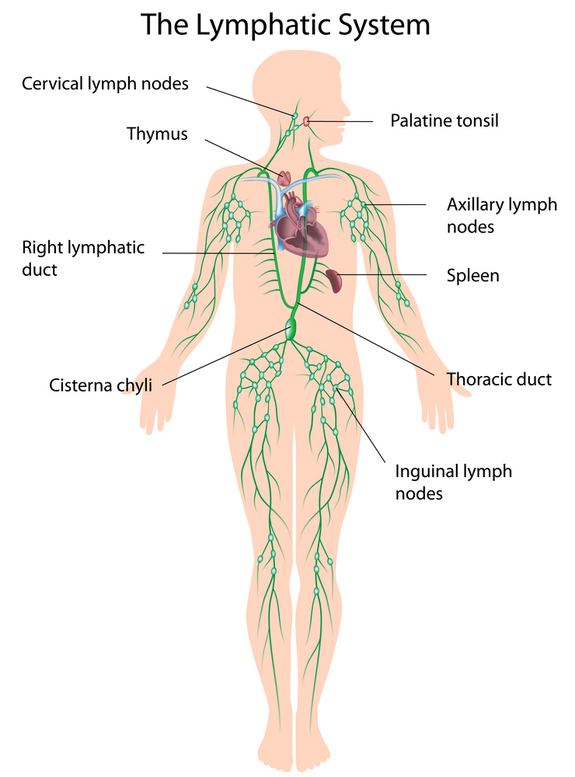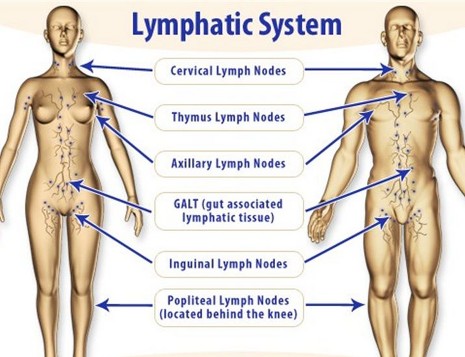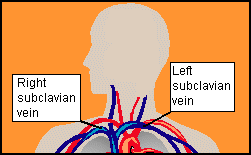ANATOMY AND PHYSIOLOGY: THE LYMPHATIC SYSTEM
Online 12 hour CEU Approved by The Texas Massage Therapists Board
Texas DSHS Licensed Online CEU Provider CE 1608 Dan C. PhD EMT LMT MTI Granbury, TX
TAKE EXAM" or Email minimum 3 page report on the Lymphatic System Study Material you have reviewed to "info@cleanwater4.us" for the 12 hour CEU Certificate
VIDEOS
Watch this Introductory Slide Show Introductory Lymphatic System Slide Show
Watch this Detailed Slide Show Detailed Lymphatic System Slide Show
The Lymphatic System
The primary function of the lymphatic system is to transport lymph, a clear, colorless fluid containing white blood cells that helps rid the body of toxins, waste and other unwanted materials.
Lymphatic comes from the Latin word lymphaticus, meaning "connected to water," as lymph is clear.
The lymphatic system, which is a subset of the circulatory system
, has a number of functions, including the removal of interstitial fluid, the extracellular fluid that bathes most tissue. It also acts as a highway, transporting white blood cells to and from the lymph nodes into the bones, and antigen-presenting cells to the lymph nodes.
Description of the lymphatic system
The lymphatic system is a network![]() of tissues and organs that primarily consists of lymph vessels, lymph
nodes and lymph. The tonsils, adenoids, spleen and thymus are all part
of the lymphatic system.
of tissues and organs that primarily consists of lymph vessels, lymph
nodes and lymph. The tonsils, adenoids, spleen and thymus are all part
of the lymphatic system.
There are 600 to 700 lymph nodes in the human body that filter the lymph before it returns to the circulatory system.
The spleen, which is largest lymphatic organ, is located on the left side of the body just above the kidney. Humans can live without a spleen, although people who have lost their spleen to disease or injury are more prone to infections.
The thymus, which stores immature lymphocytes and prepares them to become active T cells, is located in the chest just above the heart.
Tonsils are large clusters of lymphatic cells found in the pharynx. Although tonsillectomies occur much less frequently today then they did in the 1950s, it is still among the most common operations performed and typically follows frequent throat infections.
When bacteria are recognized in the lymph fluid, the lymph nodes make more infection-fighting white blood cells, which can cause swelling. The swollen nodes can sometimes be felt in the neck, underarms and groin.
Unlike blood, which flows throughout the body in a continue loop, lymph flows in only one direction – upward toward the neck – within its own system. It flows into the venous blood stream through the subclavien veins, which are located on either sides of the neck near the collarbones.
Plasma leaves the cells once it has delivered its nutrients and removed debris. Most of this fluid returns to the venous circulation through the venules and continues as venous blood. The remainder becomes lymph.
Lymph leaves the tissue and enters the lymphatic system through specialized lymphatic capillaries. About three-quarters of these capillaries are superficial capillaries that are located near the surface of the skin. There are also deep lymphatic capillaries that surround most of the body’s organs.
There are two drainage areas that make up the lymphatic system. The right drainage area handles the right arm and chest. The left drainage area clears all of the other areas of the body, including both legs, the lower trunk, the upper left portion of the chest, and the left arm.
History of Lymphatic Drainage
Manual lymphatic drainage (MLD) was pioneered by Danish Drs. Emil Vodder, a native of Copenhagen who lived on the French Riviera, a Danish physical therapist, and Estrid Vodder, a naturopath in the 1930s for the treatment of chronic sinusitis and other immune disorders. While working on the French Riviera treating patients with chronic colds, the Vodders noticed these patients had swollen lymph nodes.
In the 1930s, it was considered taboo to tamper with the lymphatic system due to the medical profession's poor understanding of this system. The Vodders were not deterred by this and, in 1932, began to study the lymph system, developing careful hand movements to cause lymph movement. In 1936, after four years of research, they introduced this technique in Paris, France.
While he studied medicine, he did not earn a medical degree because of illness. He earned a doctorate in philosophy because of his work in art history.
In 1985 the German Massage and Physical Therapy Association awarded him the Röhrbach-Medal as appreciation for his life work. It confirmed the Emil Vodder created the method and gave it the name Dr. Vodder's Manual Lymph Drainage.
Lymph Drainage Definition

MLD encourages lymph flow in the body. It is particularly good for detoxification, edema, pre- and post-plastic surgery and post-liposuction. It can also help with cellulite treatments, scar tissue, spider veins, redness and acne.
The lymph system is a slow-moving system of vessels and lymph nodes that is supplementary to the body's system of blood circulation. The lymph systen both delivers nutrients to the cells and carries away excess water, cellular waste, bacteria, viruses and toxins.MLD stimulates the lymph system and helps drain puffy, swollen tissues, supports the body's immune system, helps the body heal from surgery, and aids in the body's natural waste removal or detoxification.
Background on Lymphatic Drainage

MLD helps deliver cellular waste and microscopic villains like viruses and bacteria, which may cause cellulite, to the lymph nodes. These filter-like masses, which are found from head-to-toe, deliver this material to the liver, kidneys, and lungs. This drainage is essential because the lymphatic system lacks a pump of its own to transport the lymph through the body and must rely on movement, muscular contraction, and massage to flush the fluid.
MLD is intended by proponents to encourage the natural drainage of the lymph from the tissues space body. The lymph system depends on intrinsic contractions of the smooth muscle cells in the walls of lymph vessels (peristalsis) and the movement of skeletal muscles to propel lymph through the vessels to lymph nodes and then beyond the lymph nodes to the lymph ducts which return lymph to the cardiovascular system. MLD stimulates lymph flow and is now recognized as a primary tool in lymphedema management.
MLD not only stimulates the vital functions of the skin, tissues and internal organs, but also serves to eliminate cellular waste and stimulate the parasympathetic relaxation response inhibiting muscle tonus and pain. Research has also shown that MLD stimulates the immune system to produce more immunity, a valuable contribution to winter health!
Recognition
MLD is now recognized as a primary tool in lymphedema management. Scientific studies show mixed results regarding the efficacy of the method in treating lymphedema and further studies are needed. A 2009 meta-analysis of studies in the area of sports medicine and rehabilitation showed best evidence of effectiveness for Manual lymphatic drainage treatment to "enzyme serum levels associated with acute skeletal muscle cell damage as well as reduction of edema [swelling] around broken bones." A 2013 systematic review of manual lymphatic drainage with regard to breast cancer related lymphedema found no clear support for the effectiveness of the intervention in either preventing limb edema in at risk women or treating women for the condition.
Diseases of the lymphatic system
Diseases and disorders of the lymphatic system are typically treated by immunologists. Vascular surgeons, dermatologists, oncologists and physiatrists also get involved in treatment of various lymphatic ailments. There are also lymphedema therapists who specialize in the manual drainage of the lymphatic system.
Lymphedema is a chronic swelling of the limbs caused by the accumulation of lymph fluid that occurs if the lymphatic system is damaged or not functioning properly. While the limbs are typically involved, the face, neck and abdomen may also be affected. Many develop the disorder following cancer therapy — particularly breast cancer where the lymph nodes under the arms are removed — recurrent infections, injuries or vascular surgery.
Hodgkin's lymphoma is a type of cancer that typically occurs when the white blood cells in the body become diseased or damaged.
Castleman disease is caused by benign tumors that affect the lymph nodes. While not specifically a cancer, it is a similar to a lymphoma and is often treated with chemotherapy. Localized Castleman disease affects the lymph nodes of the stomach and chest. Multicentric Castleman disease affects greater than one region of lymph nodes as well as lymphoid-containing organs such as the spleen.
Lymphangiomatosis is a disease involving multiple cysts or lesions formed from lymphatic vessels.
In elephantiasis, infection of the lymphatic vessels causes a thickening of the skin and enlargement of underlying tissues, especially in the legs and genitals.
Lymphangiosarcoma is a malignant soft-tissue tumor, whereas lymphangioma is a benign tumor occurring frequently in association with Turner syndrome.
Lymphangioleiomyomatosis is a benign tumor of the smooth muscles of the lymphatics in the lungs.
Lymphoid leukemias and lymphomas are called "leukemia" when in the blood or marrow and "lymphoma" when in lymphatic tissue.
Lymphatic filiaris is a disease in which parasitic worms infiltrate the lymph system via the bite of a mosquito. About 120 million people worldwide are affected by this disease.
THE LYMPHATIC SYSTEM IS COOPERATIVE
![[ Major lymphatic landmarks ]](The%20Lymphatic%20System_files/a_003.gif) |
Major lymphatic ducts. |
- The lymphatic system aids the immune system in removing and destroying waste, debris, dead blood cells, pathogens, toxins, and cancer cells.
- The lymphatic system absorbs fats and fat-soluble vitamins from the digestive system and delivers these nutrients to the cells of the body where they are used by the cells.
- The lymphatic system also removes excess fluid, and waste products from the interstitial spaces between the cells.
THE TRANSFORMATION
Arterial blood carries oxygen, nutrients, and hormones for the cells. To reach these cells it leaves the small arteries and flows into the tissues. This fluid is now known as interstitial fluid and it delivers its nourshing products to the cells. Then it leaves the cell and removes waste products.
After this task is complete, 90% of this fluid returns to the circulatory system as venous blood.
WHAT IS LYMPH?
The remaining 10% of the fluid that stays behind in the tissues as a clear to yellowish fluid known as lymph.
- Unlike blood, which flows throughout the body in a continue loop, lymph flows in only one direction within its own system. This flow is only upward toward the neck. Here, it flows into the venous blood stream through the subclavien veins which are located on either sides of the neck near the collarbones.
- After plasma has delivered its nutrients and removed debris, it leaves the cells. 90% of this fluid returns to the venous circulation through the venules and continues as venous blood.
- The remaining 10% of this fluid becomes lymph which is a watery fluid that contains waste products. This waste is protein-rich due to the undigested proteins that were removed from the cells.
LYMPHATIC CIRCULATION
The lymph is moved through the body in its own vessels making a one-way journey from the interstitial spaces to the subclavian veins at the base of the neck.
- Since the lymphatic system does not have a heart to pump it, its upward movement depends on the motions of the muscle and joint pumps.
- As it moves upward toward the neck the lymph passes through lymph nodes which filter it to remove debris and pathogens.
- The cleansed lymph continues to travel in only one direction, which is upward toward the neck.
- At the base of the neck, the cleansed lymph flows into the subclavian veins on either side of the neck.
 |
|
Lymph returning to the subclavian veins. |
THE ORIGIN OF LYMPH
Lymph originates as plasma (the fluid portion of blood). The arterial blood, which flows out of the heart, slows as it moves through a capillary bed. This slowing allows some plasma to leave the arterioles (small arteries) and flow into the tissues where it becomes tissue fluid.
- Also known as extracellular fluid, this is fluid that flows between the cells but is not into the cells. This fluid delivers nutrients, oxygen, and hormones to the cells.
- As this fluid leaves the cells, it takes with it cellular waste products and protein cells.
- Approximately 90% of this tissue fluid flows into the small veins. Here it enters the venous circulation as plasma and continues in the circulatory system.
- The remaining 10% of the fluid that is left behind is known as lymph.
LYMPHATIC CAPILLARIES
In order to leave the tissues, the lymph must enter the lymphatic system through specialized lymphatic capillaries. Approximately 70% of these are superficial capillaries located near, or just under, the skin. The remaining 30%, which are known as deep lymphatic capillaries, surround most of the body’s organs.
Lymphatic capillaries begin as blind-ended tubes that are only a single cell in thickness. These cells are arranged in a slightly overlapping pattern, much like the shingles on a roof. Each of these individual cells is fastened to nearby tissues by an anchoring filament.
LYMPHATIC VESSELS
The lymphatic capillaries gradually join together to form a mesh-like network of tubes that are located deeper in the body.
- As they become larger, and deeper, these structures become lymphatic vessels.
- Deeper within the body the lymphatic vessels become progressively larger and are located near major blood veins.
- Like veins, the lymphatic vessels, which are known as lymphangions, have one-way valves to prevent any backward flow.
- Smooth muscles in the walls of the lymphatic vessels cause the angions to contract sequentially to aid the flow of lymph upward toward the thoracic region. Because of their shape, these vessels are previously referred to as a string of pearls.
LYMPH NODES
![[ Interior of a lymph node ]](The%20Lymphatic%20System_files/a.jpg) |
Lymph nodes kill pathogens and cancer cells. They also remove debris and excess fluids. |
There are between 600-700 lymph nodes present in the average human body. It is the role of these nodes to filter the lymph before it can be returned to the circulatory system. Although these nodes can increase or decrease in size throughout life, any nodes that has been damaged or destroyed, does not regenerate.
- Afferent lymphatic vessels carry unfiltered lymph into the node. Here waste products, and some of the fluid, are filtered out.
- In another section of the node, lymphocytes, which are specialized white blood cells, kill any pathogens that may be present. This causes the swelling commonly known as swollen glands.
- Lymph nodes also trap and destroy cancer cells to slow the spread of the cancer until they are overwhelmed by it.
- Efferent lymphatic vessels carry the filtered lymph out of the node so that it can continue its return to the circulatory system.
DRAINAGE AREAS
Lymphatic system drainage is organized into two separate, and very unequal drainage areas. The right drainage area clears the right arm and chest. The left drainage area clears all of the other areas of the body including both legs, the lower trunk upper left of the chest, and the left arm.
 |
|
Lymphatic Drainage Areas |
Detailed Lymphatic System Interactive Review.
This review will take over 8 hours approximately and you should be ready for the exam after this
WHY THIS INFORMATION IS SO IMPORTANT
- Damage disturbs the flow. When lymphatic tissues or lymph nodes have been damaged, destroyed or removed, lymph cannot drain normally from the affected area. When this happens excess lymph accumulates and results in the swelling that is characteristic of lymphedema.
TAKE EXAM" or Email minimum 3 page report on Lymphatic System Material reviewed to "info@cleanwater4.us" for 12 hour CEU Certificate
Visit www.txmassageceu.com to pay $43 online by using your credit card or paypal a/c for the Lymphatic System 12 hour CEU Course